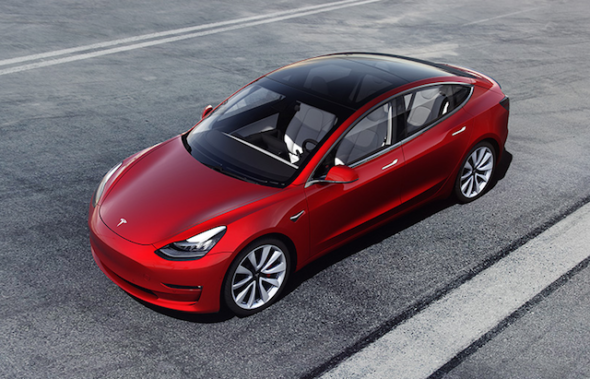Is It Financially Insane to Buy Any Car Besides a Tesla?

At Tesla’s Autonomy
Investor Day, Elon Musk had a show-stopping moment when
he proclaimed that by the end of 2020, there would be one million Tesla “robotaxis” in service, providing owners with the potential to make $30,000 a year. Was it realistic? That truly doesn’t matter. Here’s what the robotaxi does for Tesla:
1. Creates Immediate Lift in Consideration from Consumers
The possibility of the robotaxi service may push those consumers currently researching a Tesla over the edge. Early adopters loved Tesla because of the technology and the “it” factor, and those who love Tesla continue to buy its vehicles, as the company has one of the highest loyalty percentages in automotive. However, Tesla needs to convince those buyers on the fence between a Tesla and a car from another luxury automaker (Lexus, Mercedes-Benz, Audi, BMW, Volvo) to purchase a Tesla over the competition, and the potential income from a robotaxi makes a compelling case.
Many early responses sound skeptical about Tesla’s plan to launch
a robotaxi that will provide each customer with $30,000 a year in income. Although Mr. Musk has admitted to missing his self-set target dates and often falls short of his grand proclamations, he still lands among the stars when he was aiming for the moon. Vehicle shoppers, who
are generally well-informed prior to purchase, may come to the conclusion that Mr. Musk will miss his 2020 deadline and has inflated the $30,000-a-year income claim. But if Mr. Musk launches the robotaxi by 2022 and Tesla consumers earn $10,000 a year from the service, that would still be a significant windfall
for Tesla owners and one that may drive increased brand consideration.
2. Differentiates the Tesla Brand Within the Soon-to-Be-Crowded EV space
Tesla has played in the EV space with limited competition until this year. With the Jaguar I-PACE, Audi e-tron, and Porsche Taycan all coming to market, Tesla’s focus on autonomous cars and a robotaxi service will once again help differentiate the brand. For instance, Porsche’s announcement of the Taycan was focused on driving competition with Tesla, as Porsche was losing customers and wanted a Tesla killer rather than a Tesla fighter. However, as Tesla and Mr. Musk always seem to do, rather than focusing on the competition, they sought to differentiate Tesla by trying to become the first to market with Level 5 autonomous driving and income from robotaxi service. Mr. Musk knows he and Tesla will never win those consumers who want to drive a Porsche and instead intends to differentiate the Tesla brand by appealing to rational consumers.
3. Turns a Tesla into an Investment
During the live stream, Mr. Musk alluded to the fact that vehicles sit more often than they get used. This is true. The most common use for vehicles is getting from parking spot A to parking spot B and back to parking spot A much later the same day, resulting in vehicles sitting unused most of the time. Letting owners generate income with a vehicle while they don’t need it makes a great sales pitch, which Tesla may need after it loses its EV tax credit on December 31, 2019. Tesla’s 2020 marketing tagline, if it marketed its vehicles, could be, “Would you rather receive a $7,500 tax credit or $30,000 a year?” Mr. Musk essentially did this at investor’s day, saying “It’s financially insane to buy anything other than a Tesla.”
4. Enables Tesla to Launch a Ride-Hailing Service
Assuming both robotaxi and Level 5 autonomous cars come to market, Mr. Musk will be able to add to his collection of businesses with the addition of a ride-hailing company to compete with Uber and Lyft. The main difference for Mr. Musk is that he won’t need drivers. Whether this is a Tesla-owned company or a spin-off, it would produce an additional revenue stream and give the brand the ability to send its off-lease vehicles to the ride-hailing company, as long as older Tesla vehicles can be retrofitted with the technology. A ride-hailing company would also allow Tesla to place new vehicles in its fleet, keeping factories running at full capacity and allowing Tesla to keep per-unit production costs low if there were ever a lull in product demand.
But Will It Launch in 2020?
Marcus Aurelius said we can foresee the future if we look at the past, and it’s unlikely that Mr. Musk will accomplish all three goals by the end of 2020: one million robotaxis on the road, a $30,000 income stream for consumers, and Level 5 autonomous cars. However, Mr. Musk doesn’t need to hit his target date to be a disruptor, he just needs to eventually get it done.
If Mr. Musk’s robotaxi concept convinces consumers to
consider a Model 3, he was successful. His proclamations at Tesla’s Autonomy
Day have garnered Tesla millions of dollars’ worth of free marketing. They likely
drove customers to the Tesla website to price a Tesla, and many may have added one
to their consideration set. Increasing awareness and driving consideration is something
most automotive companies pay millions of dollars to accomplish. It matters less
whether Mr. Musk hits his targets and significantly more that he convinced
consumers to consider or purchase a Tesla in hopes of earning $30,000 a year by
2020.

Comments
Post a Comment